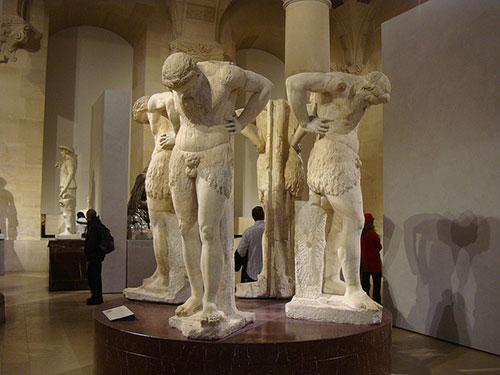Today in Tedium: It's the one thing that separates humans from androids. Like the appendix, it's functionally useless—minus the period before you're actually born, when it's pretty much the most important part of your body. Unlike the appendix, it's visible and easy to spot. It, of course, is the belly button—one of the most-common but least-discussed parts of the human body. (Well, unless you're Taylor Swift.) Innie or outie? The answer to that question could very well define your life. — Ernie @ Tedium

Navel gazing is not just a saying, as it turns out
Omphaloskepsis. It's one of the oddest, weirdest words in the dictionary, but it's a word that ties Greek philosophers to the concept of staring at one's navel. Which makes sense, obviously—without smartphones and Candy Crush notifications, they had a lot of time to think about stuff.
Originally seen as a concept tied to meditation, navel gazing is now perceived as something much more banal—shorthand for thinking of nothing in particular besides oneself, for engaging in narcissism.
Part of the reason for that is the first proper reference to navel gazing in literature, in the 1856 book Hours With the Mystics, organized by British minister and writer Robert Alfred Vaughan.
In a section of the book highlighting monks around Greece's Mount Athos, he wrote this:
"It seems that some of the monks (called, if I mistake not, Hesychasts) held that if a man shut himself up in a corner of his cell, with his chin upon his breast, turning his thoughts inward, gazing towards his navel, and centering all the strength of his mind on the region of the heart; and, not discouraged by at first perceiving only dark- ness, held out at this strange inlooking for several days and nights, he would at length behold a divine glory, and see him- self luminous with the very light which was manifested on Mount Tabor. They call these devotees Navel-contemplators. A sorry business! All the monks, for lack of aught else to do, were by the ears about it, either trying the same or reviling it."
So basically, because some guy mocked a bunch of monks for focusing on their navels in a religious sense, we've got a phrase about staring at one's belly button.
But despite the negative rep that navel gazing holds, it nonetheless still remains an important point of notice in certain contexts—most notably with the concept of the navel chakra, a spot on the spine directly behind one's navel that is considered an important energy center in the art of yoga.
Following the logic all the way through, your belly button is the area where your self-esteem lies. That's certainly a better fate for what's essentially an umbilical scar than the center of all your self-absorbed habits.
2,368
The number of bacterial species belly button researchers found in analyzing 60 different belly buttons back in 2012. Of those, according to researchers with North Carolina State University, 1,458 types of the bacteria found may be new to science.
Five things that people actually researched about belly buttons
- The placement of a navel can be a key to whether you'll be successful or even any good at sports, according to a 2010 Duke University study. Innie or outies don't matter so much as the placement of the navel, which acts as your center of gravity.
- Men are more likely to get belly button lint, according to research done by Dr. Karl Kruszelnicki, a popular Australian scientist who won an Ig Nobel Prize in 2002 for a far reaching study of nearly 5,000 belly buttons. The reason? Men are more likely to have hair on their stomachs. Kruszelnicki adds that there's a certain reason why specific colors usually pop up. "The reason it is usually blue is that we mostly wear blue or grey trousers, often jeans, and when these rub against the body, the fibers often end up finding their way to the navel,"Kruszelnicki told The Telegraph in 2009.
- If you buy a new undershirt, plan for a little extra belly lint. However, if you're wearing a shirt that's been around the block a few times, the odds of lint are way lower. A University of Vienna researcher figured this out by analyzing his own belly button. Seems like a reasonable use of his time.
- On the more useful research front, a 2013 study in the British Journal of Surgery finds that if you're going to get an appendectomy, the best spot to get one could be through the navel, because the end result limits the amount of noticeable scarring.
- On the less useful research front, a 2014 study by the American Society for Aesthetic Plastic Surgery found that an oval-shaped belly button is considered most attractive, but the study was done before the rise of the dad bod, so there's a chance this research is out of date.
"The raw material is worthless but as a unique world record collection and a piece of cultural heritage, of debatable merit, it has some curiosity value."
— Record-setting lint collector Graham Barker, discussing how he got rid of the results from his most amazing feat—saving belly-button lint over a 26-year period, something he did because he essentially was bored and curious. His feat got him in Guinness World Records, because of course it did.

Could this be the Earth's belly button?
A while back, photographer John Fowler shared a picture of a bizarre rock structure inside of Utah's Grand Staircase-Escalante National Monument. The monument has an odd nickname—the "Cosmic Navel," and much like your traditional navel, there's something hiding inside: sand.
"The formation is hard to photograph in direct sunlight because part of it will always be in shadow and part in bright light," Fowler explained. "I hung around until sunset to get this shot. In the fading light I hurried down the steep slick rock before it became too dark to see."
Researchers that have analyzed the rock formation in the past say the result is due to a river once flowing through the rock, but we all know the truth—Mother Nature gets belly button lint, too.
Of the few things that differentiate identical twins from one another, a key one may be the belly button. While fingerprints tend to be different between pairs of twins, as might birthmarks and moles, belly buttons tend to be among the most practical ways to spot them, simply because there's no way an umbilical cord is going to break off the exact same way on two different children.
Navels tend to come in all shapes and sizes—though generally as innies, rather than outies. They're one of the most common signifiers that we came from somewhere else, that we didn't just show up here one day fully formed.
And though despite the long history of navels, we're still figuring out new things about navels, analyzing them and trying to better understand the many secrets they hold.
If this sounds deep and self-indulgent, that's because it usually is.




